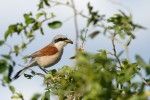Shrikes of Estonia
Great Grey Shrike

Great grey shrike
Valeri Štšerbatõh
Great Grey Shrike can be met all around the year and the species is sparsely distributed throughout the whole country. As a breeder it is rather small in number though, not exceeding 300-500 breeding airs. During the breeding season the birds are active in raised bogs. They are more often met from September and October, when migration begins and the birds are often seen in cultural landscapes. Great Grey Shrikes, which breed in Estonia, migrate mostly southwards, simultaneously there are birds, who arrive from the North to winter here around. The number of Great Grey Shrikes staying here is estimated about 500-600 specimen. In wintertime they can be met most often in cultural landscapes, less in clearings.
Red-backed Shrike

Red-backed Shrike
Remo Savisaar
Red-backed Shrike – a migratory bird, wintering in Africa – is a common breeder in Estonia. Usually they arrive here in the middle of May. Males arrive couple of days before females (2-5 days according to the study, carried out in Sweden). Majority of the birds are leaving already in August. Only some few lone immature birds are still here in September.
Red-backed Shrike is a widely spread and numerous breeder, whose number has increased recently, after a relatively unfaourable period. In 1998-2002 the estimated abundance was 20 000 – 35 000 breeding pairs, while in 2003-2008 there were already 40 000 – 60 000 pairs.
The birds begin nesting right after they arrive. The nest is located low (0,2-6 m), occasionally even on the ground. Red-backed Shrike is nesting in opened or semi-opened landscapes. Around the nesting site it needs treeless areas for prowling and bushes or hedges for nesting.
The nest is usually in a thick bush, hedge or juniper stand, infrequently on a larger tree. According to the nesting card data from 1942-2001 (total of 331 nest finds) the most frequent nest locations were spruce (40%) and juniper (10%). Settlement area is the most frequently mentioned nesting biotope (15,8%), followed by clearing (12%) and wooded meadow (11,7%). Full clutch nests with mostly 5-7 eggs can be found from the end of May or the beginning of June. Red-backed Shrike, atypically for a passerine, is in the nesting and hatching period exceptionally sensitive to disturbing and may abandon its nest easily.
Woodchat Shrike
The nearest breeding areas of the Woodchat Srike are situated in Southern Europe, where it is the commonest shrike species. It nests also in Middle Asia and Northwestern Africa. For wintering it migrates to the Southern part of Africa. In Northern Europe the Woodchat Shrike is a rare accidental visitor. In Estonia the species has been watched only three times – in the autumn 1972 when a first-summer juvenile bird was caught and ringed in Kabli Bird Station, then in June 2005 when a Woodchat Shrike was observed in Tartumaa County and once more in May next year in Saaremaa.
Isabelline Shrike
Isabelline Shrike is breeding in South Siberia, West Asia and Northern part of China. Wintering areas of the species range from Northwestern India to East-Africa. In Europe the Isabelline Shrike is a rare accidental visitor – beginning with 1854 (first official observation in Europe) up to these days the species has been observed throughout the whole Europe only about 120 times. For instance in Finland there are only five accepted observations. In Estonia the Isabelline Shrike has been met only once – on 15 October 2001 a first-summer juvenile was caught and ringed in Kabli Bird Station.
Lesser Grey Shrike
Lesser Grey Shrike is the most frequent accidental visitor shrike in Estonia. The reason is evidently logical, as the closest breeding sites are in Poland and Southern part of Lithuania. There are 28 accepted observations of the Lesser Grey Shrike as of 30 October 2009. Beginning with 2000 there have been 8 observations. The species is mostly encountered (almost 50% of the times) in late May or early June. In the autumn there have been only occasional observations.




